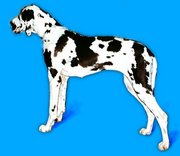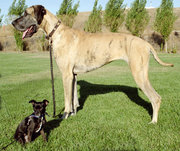Great Dane
The Great Dane is a breed of dog known for its large size (giant) and gentle personality. The breed is commonly referred to as the "Gentle Giant". more...
Appearance
There are six show-acceptable coat colors for Great Danes.
- Fawn: Yellow gold with a black mask. Black should appear on the eye rims and eyebrows, and may appear on the ears and tail tip.
- Brindle: Fawn and black in a chevron stripe pattern. Often also referred to as a tiger-stripe pattern.
- Blue: Deep grey with a bluish tinge. Reminiscent of Weimaraners.
- Black: Pure jet black.
- Harlequin: Torn black patches on white. The Great Dane is the only dog breed that shows this particular coat color pattern. (Dalmatians have round black spots.)
- Mantle: Black coat and mask on white. Looks like the markings on Boston Terriers.
Other colors occur occasionally but are not acceptable in the show ring. Because they are not valid for show dogs, they are not pursued by breeders. These colors include white, fawnequin, merle, merlequin, fawn mantle, and others. These are sometimes advertised as "rare" colors to unsuspecting buyers. Any coat that includes "mouse grey" is disqualified from show.
Cropping of the ears is common in the United States and much less common in Europe. Indeed, in some European countries, in parts of Australia, and in New Zealand, the practice is banned, or controlled such that it may only be performed by veterinary surgeons for health reasons.
Height and weight requirements for show dogs vary from one kennel club's standards to another, but generally the minimum weight falls between 100 to 120 lb (46 to 54 kg) and the minimum height must be between 28 and 32 inches (71 to 81 cm) at the withers. Most standards do not specify a maximum height or weight.
Temperament
Typically they are smart, strong dogs who are protective and loyal to their owners. Many are gentle and delicate, although not to the extent of being timid. They take to training well and are fairly low maintenance compared to many other breeds. The Great Dane must be spirited, courageous, always friendly and dependable, and never timid or aggressive.
Health
Great Danes, like most giant dogs, have a fairly slow metabolism. This results in less energy and less food consumption per pound of dog than in small breeds.
Great Danes have some health problems that are common to large breeds. Bloat (a painful distending and twisting of the stomach) is a rare but critical condition that affects Great Danes and results rapidly in death if not quickly addressed. It is a commonly recommended practice for Great Danes to have their stomachs tacked (Gastropexy) to the interior rib lining during routine surgery such as spay/neuter if the dog or its relatives have a history of bloat. Another problem common to the breed is in the hips (hip dysplasia). Typically an x-ray of the parents can certify whether their hips are healthy and can serve as a guidline for whether the animals should be bred and are likely to have healthy pups.
Read more at Wikipedia.org




